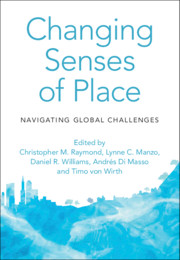Book contents
- Changing Senses of Place
- Changing Senses of Place
- Copyright page
- Dedication
- Contents
- Contributors
- Foreword
- Preface
- Acknowledgements
- Introduction
- Part I Climate Change and Ecological Regime Shifts
- Part II Migration, Mobility and Belonging
- Part III Renewable Energy Transitions
- 10 Farming Landscapes, Energy Landscapes or Both?
- 11 Auto-Photography, Senses of Place and Public Support for Marine Renewable Energy
- 12 A Life Course Approach to the Pluralisation of Sense of Place
- Part IV Nationalism and Competing Territorial Claims
- Part V Urban Change
- Part VI Technological and Legal Transformations
- Part VII Design and Planning Strategies for Changing Senses of Place
- Part VIII Conclusion
- Index
- References
10 - Farming Landscapes, Energy Landscapes or Both?
Using Social Representations Theory to Understand the Impact of Energy Transitions on Rural Senses of Place
from Part III - Renewable Energy Transitions
Published online by Cambridge University Press: 15 July 2021
- Changing Senses of Place
- Changing Senses of Place
- Copyright page
- Dedication
- Contents
- Contributors
- Foreword
- Preface
- Acknowledgements
- Introduction
- Part I Climate Change and Ecological Regime Shifts
- Part II Migration, Mobility and Belonging
- Part III Renewable Energy Transitions
- 10 Farming Landscapes, Energy Landscapes or Both?
- 11 Auto-Photography, Senses of Place and Public Support for Marine Renewable Energy
- 12 A Life Course Approach to the Pluralisation of Sense of Place
- Part IV Nationalism and Competing Territorial Claims
- Part V Urban Change
- Part VI Technological and Legal Transformations
- Part VII Design and Planning Strategies for Changing Senses of Place
- Part VIII Conclusion
- Index
- References
Summary
Social-ecological transitions are fundamentally about places – especially how place meanings and attachments act as lenses for interpreting change. Our chapter focuses on energy transitions in rural agricultural landscapes in New York. Agricultural place meanings underpin attachment for many residents, but are challenged by proposals for large-scale renewable energy development. This chapter explores how people interpret these proposed facilities using the perspective of social representations of place. multiple interpretations of proposed facilities are promoted by different groups based on their position towards the development: developers and energy advocates strategically portray solar installations as ‘farms’, replete with images they believe support agricultural meanings; those who resist these developments emphasise the large-scale industrialisation of the landscape and the loss of services such as open space and amenity value. These narratives of place contribute to understanding perspectives on energy transitions and broader rural change.
Keywords
- Type
- Chapter
- Information
- Changing Senses of PlaceNavigating Global Challenges, pp. 131 - 143Publisher: Cambridge University PressPrint publication year: 2021
References
- 2
- Cited by



